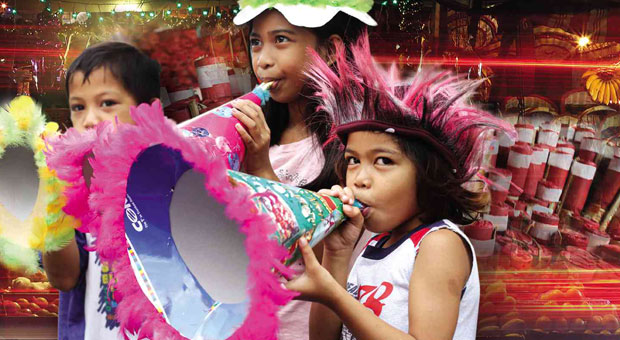Department of Health airs concern over firecracker injuries

SAFE REVELRY Quezon City authorities are encouraging children to use horns as safe alternatives to firecrackers during the days leading up to the New Year’s Eve revelry in this composite photo that also shows city street scenes of selling firecrackers in Legazpi City in Albay province and round fruits in San Andres, Manila. MARIANNE BERMUDEZ/EDWIN BACASMAS/MARK ALVIC ESPLANA/INQUIRER SOUTHERN LUZON
They never learn. Or if they do, it’s because they have lost a finger or two.
And here we are again, counting. It’s still three days before New Year’s Eve and the Department of Health (DOH) has already recorded 113 cases of firecracker injuries across the country.
The count includes a 5-year-old boy from San Mateo town, Rizal province, who ate a sparkler, mistaking it for candy.
Two other kids—a 5-year-old boy from Cebu and a 9-year-old boy from Manila—each lost a hand in firecracker explosions.
The boy from Cebu lost his right hand in the explosion of a still unknown firecracker, while the boy from Manila lost his left hand when the “piccolo” he lighted with a matchstick exploded.
Article continues after this advertisementWhen gathered and lighted together, piccolo—small, colorful and cheap—can produce a big bang, like the “bawang,” that garlic-size bulb of tightly packed powder that explodes like a grenade.
Article continues after this advertisementThe DOH considers piccolo one of the most dangerous firecrackers available in the country.
According to the DOH firecracker injury registry, which started on Dec. 21, the majority of the cases—75, or 67 percent—were injuries from piccolo explosions.
While the national tally was 86 cases, or 43 percent, lower compared with the number of injuries recorded from Dec. 21 to New Year’s Eve last year, the DOH said the trend was unacceptable, especially as some of the injuries had permanent consequences.
Intensifying campaign
“Every life is important,” acting Health Secretary Janette Garin said in a statement on Saturday. “The lower number of cases only encourages [the] DOH to intensify its campaign to stop the use of firecrackers in merrymaking to welcome the new year.”
In its 6 a.m. firecracker injury registry update on Saturday, the DOH-National Epidemiology Center said the national tally was 50 cases (31 percent) lower than the five-year (2009-2013) average.
The DOH’s label “firework-related injuries” includes direct firework injuries, firework ingestion and stray-bullet injuries.
There were 112 cases of direct firework injuries, 96 of them (86 percent) involving males ages 3 to 68.
Thirty-nine cases (35 percent) involved children younger than 10 years old.
Eighty-seven of the cases (78 percent) were blast injuries not requiring amputation, 6 cases (5 percent) blast injuries requiring amputation and 19 cases (17 percent) eye injuries.
Metro Manila had 39 percent, or 44 of the total number of cases, with Manila having the most cases at 19, followed by Pasig, with 8, and Las Piñas and Pasay City, three each.
Causing the injuries, besides piccolo, were the firecrackers called “five-star” and “camara,” and the canon-like device called “boga.”
Early cases in Bicol
In Bicol, health officials said firecracker injuries across the region had risen nearly 200 percent even before the New Year’s Eve revelry could start.
Dr. Evy Sarmiento, coordinator of the Violence and Injury Prevention Program at the regional office of the health department, said at least 21 people were hurt in playing with firecrackers between Dec. 21 and Dec. 25, an increase of 171 percent from 14 in the same period last year.
A survey taken by the health department in the region showed that most of the injuries were caused by the piccolo.
Sarmiento said all the victims suffered hand injuries and were discharged after receiving treatment in hospitals.
Albay province had the highest number of firecracker injuries, 11, followed by Masbate, 4; Camarines Sur, 3; Camarines Norte, 2, and Sorsogon, 2.
Albay hopes to see fewer cases after a police crackdown on vendors of illegal firecrackers in the cities of Legazpi and Tabaco, and the towns of Guinobatan and Polangui on Saturday.
Gov. Joey Salceda ordered the confiscation of illegal firecrackers—piccolo, atomic big “triangulo,” “superlolo,” “watusi,” “superthunder,” “goodbye Philippines” and “pop-pop”—to further reduce injuries during New Year celebrations in the province.
Senior Supt. Marlo Meneses, Albay police director, said charges were being prepared for filing against the vendors. With reports from Michael B. Jaucian and April Mier, Inquirer Southern Luzon
RELATED STORIES
30 firecracker injuries already recorded from Dec. 21 to morning of Dec. 25—DOH
1 death, firecracker injuries on holiday